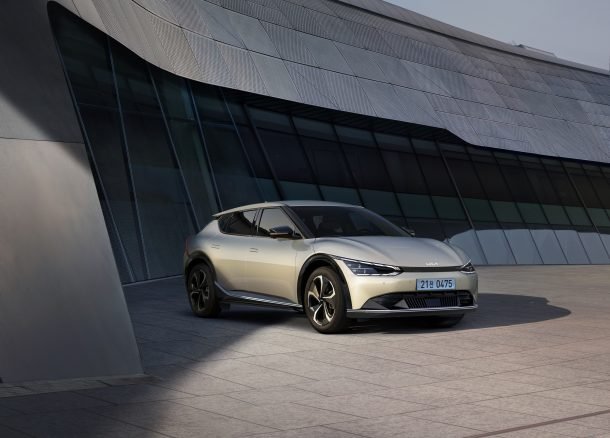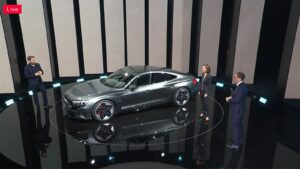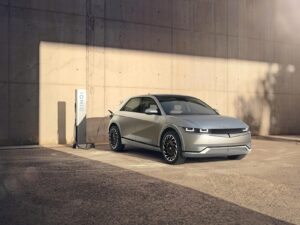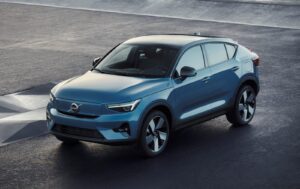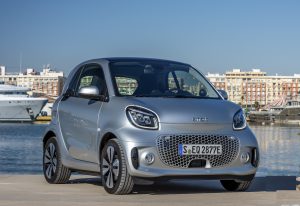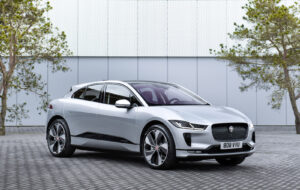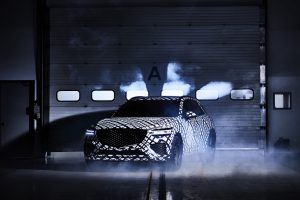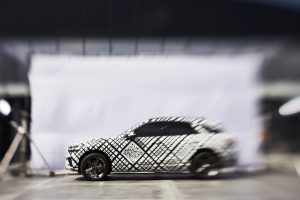I got my first, in-person taste of the upcoming Kia EV6 this past weekend in Irvine, California. It was a beautiful 77-degree day spent amid rolling hills under blue, sunny skies – even the people I met were wonderful. They were tanned, attractive, “California” people who were cheerful and engaging. No matter what California sent to distract me, though, my eyes kept turning back to the EV6.
There’s simply no escaping it. The Kia EV6, especially in the matte metallic gray finish, is an incredibly good-looking car.
Not too far away, another Korean car caught my eye. This time it was the Hyundai Ioniq 5, which I was also experiencing in production form for the first time. From a few yards away, the Ioniq 5 looks for all the world like a retro-futuristic hot hatch, low and squat and ready in the way that old rally cars seem to want to pounce off the line, and barrel towards the next curve. Then the door opens, someone steps out of the car, and your brain has to recalibrate.
It’s not a hot hatch at all. The Ioniq 5 is a medium-ish, five-passenger crossover with 21-inch wheels and high-end LED lighting. It was all a trick of the light.
“How—” I begin to ask, genuinely surprised at how small the Ioniq looks compared to how big it actually is. “How did you guys do this?”
“We hired the best people in the world,” was James Bell’s simple, straightforward response.

James Bell is Kia’s head of corporate communications and was kind enough to spend some time with me last Saturday during the Electrify Expo e-mobility festival in Irvine and help me wrap my brain around just how far Kia has come in the last two decades. Which, if you weren’t around in the 90s, let me tell you: Kia has come a long, long way.
“The company decided it was going to hire the best people it could find,” said James (I’m paraphrasing a bit here). “Not just good people, but the best people – even if that meant we had to look outside of Korea to find them.”
The team that Hyundai and Kia have put together to develop their new Electric-Global Modular Platform (E-GMP) reads like an automotive take on the Traveling Willburys.
Bell starts with Albert Biermann, who was originally hired as a chassis and suspension engineer at BMW in 1983, and who worked on every classic BMW you want while working his way up to the role of Vice President Engineering BMW M Automobiles and BMW Individual in 2008. Hyundai hired him away from BMW in 2015, specifically to ensure that the new Hyundai and Kia models built on the E-GMP platform were as good, from a dynamic perspective, as anything else.
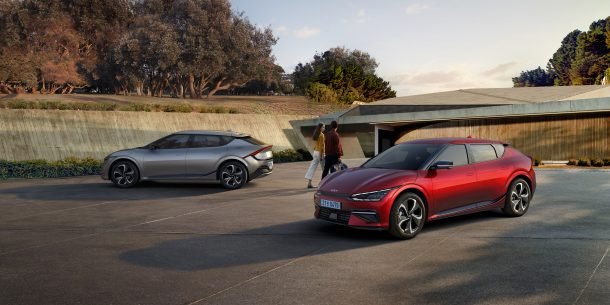
Next, he mentions Luc Donckerwolke, a superstar car designer whose portfolio includes the all-conquering Audi R8 LeMans racer, the Lamborghini Murcielago and Gallardo, and both the 2013 Bentley Flying Spur and the EXP 10 Speed 6 concept. This guy can draw cars, in other words, and he’s proved that again and again since joining Hyundai with the 2018 Palisade, 2020 Sonata, 2021 Elantra, and G/GV80 Genesis models. He oversees the look and feel of the cars.
Finally, we get to Karim Habib, another BMW alum who penned both the BMW 6 Series Gran Coupe (swoon!) and the EV6 that’s in front of us.
“I love this car,” I tell James. “I just wrote an article about it, actually. I said it looked like a Lancia Stratos.”
“That’s a good thing to look like,” he says. “There might be some Lotus, too.”

We talked a bit about some of the other players in the EV space who have – let’s say, “struggled” with translating some traditional styling cues into a modern, crossover-y electric vehicle design language, and whether those styling cues were doing more to hurt or help those brands as they transition to EV.
“Do you think that Kia, because it’s kind of a younger brand with maybe less of a legacy, has more freedom to make really bold design choices?”
“Yeah,” James says, thoughtfully. “Yeah, I think so. The design language that Kia has is really forward-looking. When I was at GM, there were a lot of ‘competing interests’, shall we say?”
We joke a bit about Fiero/Corvette conspiracy theories and a “You can’t have a coupe; Buick just got a coupe!” mentality.
“At Kia,” he says, “there’s none of that.”
It’s clear just from the EV6 that Karim Habib is making the most of his opportunity to lead a design department that isn’t beholden to the past.
“EV6, as the first dedicated Kia EV, is a showcase of human-centered, progressive design and electrified power,” Habib said, in Kia’s official statement on its new, “Opposites United” design philosophy. “The philosophy is based on five key design pillars,” the statement continues. “‘Bold for Nature’, ‘Joy for Reason’, ‘Power to Progress’, ‘Technology for Life’, and ‘Tension for Serenity’.”
Which, I mean – that’s some pretty dense PR-speak that I really want to take issue with … but I can’t. The EV6 really does look bold, and I want to put some aggressively knobbed tires on it and take it out into nature. It looks joyful in the way that sportscars look fun and thrilling, but it’s a four-door crossover that I can make a logical case for. As for power – well, Kia did debut the 576 horsepower EV6 GT by lining it up alongside a Lamborghini, an AMG, a McLaren, a Ferrari, and a Porsche for an airstrip drag race.
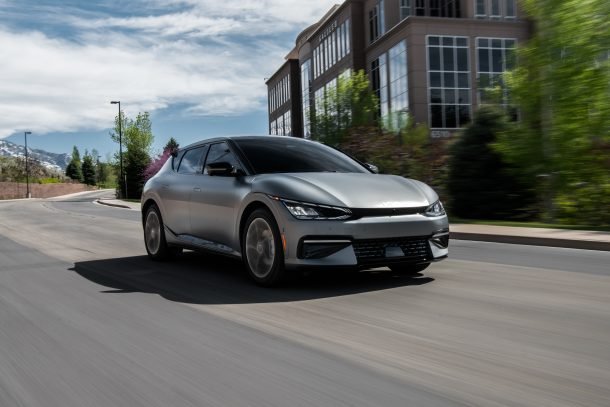
The Kia didn’t win that race (the McLaren won), but it wasn’t last. Not by a long shot – and that says a lot about what Kia seems to have figured out about the car business: People build cars. And, if you hire the best people to build your cars, it makes sense that you’re probably going to end up building the best cars. Or some very good ones, at least.
With handling by the guy who made BMW M into the BMW M, a forward-looking design language, and the guy who brought Lamborghini and Bentley into the modern era keeping an eye on things, it’s hard to imagine Hyundai and Kia doing anything else.
James was a very good sport and spent a lot of time talking cars and Kia with me at the Electrify Expo. I wanted to return the favor, so I asked him if there was any point or message about Kia that he’d like to add to the article. After a bit of a pause, he hit me with the following: “We believe the launch of the EV6 will be long remembered as a pivotal moment in the history of Kia here in the US. It will be our proverbial ‘vehicle of change’ as you will never forget the first time you see one on the road, and therefore is a perfect representation of Kia’s new Opposites United design theme.”
“I love it!” I said with a chuckle.
“Hopefully you can sense that I LOVE the car biz!” he added.
I do get that sense. I love it, too.
[Images: Kia, Hyundai]
Become a TTAC insider. Get the latest news, features, TTAC takes, and everything else that gets to the truth about cars first by subscribing to our newsletter.
Related
For GREAT deals on a new or used Land Rover check out Envision Land Rover TODAY!

